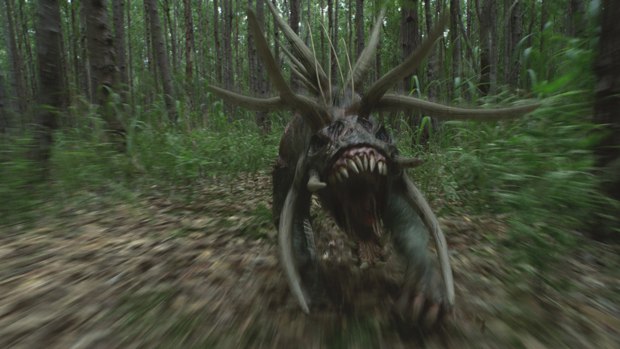Read all about Hybride's ferocious alien dogs.
Check out the Predators trailers and clips at AWNtv!
In Predators, a mercenary (Adrien Brody) leads a team of elite warriors that realizes it has been selected as prey on an alien planet. Directed by Nimród Antal and produced by Robert Rodriguez, Predators returns to the alien design of the first two films (Rodriguez's Troublemaker Studios collaborated on the Black Super Predators with KNB FX Group, which are not CG).
However, Hybride and Ubisoft Digital Arts collaborated on the CG Predator Hounds, which controlled by the Predators to flush out their prey much like a fox hunter uses its hounds. Hybride and UDA not only handled the Hounds but also moments when the Hounds interact with the jungle environment. Hybride artists replaced real leaves and debris during shooting with their own CG greenery.
"These are like Hell Hounds: very mean and nasty, so, of course, they were built and textured in CG and we had to integrate them into the plates of the live shooting," explains Philippe Théroux , lead CG supervisor for Hybride. "Sometimes the guns on their shoulders were animated in CG; the blade of the Predator was sometimes CG." In all there were 470 shots.
Hybride was provided with designs for the Hounds from Troublemaker, but the large, protruding horns proved problematic when hunting their prey, so a little tweaking was done in consultation with the director. For the Hounds, Hybride used ZBrush and Softimage and they had to be photoreal.
"The humans use machine guns and shot guns to kills them so we had to create models of the Hounds half-destroyed with limbs missing and bullet holes in their heads or horns shattered," Théroux continues. "We created a bank of models and were able to bring them in the scene with animation, depending on the cut and the progression of wounds, to get good continuity.
"The challenge of the Hounds was the same kind of problem you have when animating an outer space creature that doesn't exist. It was striking a balance between a heavy, mean look but having the ability to also move swiftly. So we had to be careful that they didn't look too light when they jumped to take a human down."
According to Daniel Leduc, Hybride's visual effects producer, the CG jungle was the biggest challenge because of the interaction. "We had to have those quadrupeds run in two paths that were covered with dead leaves," Leduc suggests. "So to have those leaves moving or being pushed or flying around as the Hounds were running was a challenge. In all of the shots, we recreated the path entirely in CG and did a simulation of the dead leaves and twigs that were on the forest floor. The simulation was done with ICE and the render in XSI with mental ray.
"For every layout, we had the Lidar scan of the jungle, so looking at the footage -- the information about the camera and the lens-- we were able to match the lidar model with the actual live plate. We had the dips in the ground and the trunks of the trees, so it was very helpful for the layout workload but also to create the shadows of the trees on the CG model, to create the bullet impact as the humans shoot the Hounds."
This also necessitated R&D in the creation of a forest generator with Softimage's ICE and various plug-ins. "In many scenes, we had to do some set extensions from the jungle or in some scenes we created an entire CG jungle as well, which we created using ICE again as a quick way to populate a scene with trees," adds Théroux."We had pictures of the jungle and modeled the plants with the same shape and texture; we made a bank of the native plants, depending on the sets, and with our plug-ins, we were able to populate an entire set with the corresponding CG plants, trees and vegetation. Of course, we had to make sure everything could render in mental ray, so these scenes were very heavy.
"And we have a long traveling shot where it goes from a lake and flies over some people and goes up a cliff and we end up in the camp of the Predators. And we had to create an entire jungle to match two plates together. The beginning and end were live but everything in the middle was CG. No matter how good the animation was, if the interaction with the jungle wasn't believable, you never would've believed it was shot there with the plates."
Meanwhile, augmentation was done on the Predators, too, including blood, light simulation (muzzle flash, plasma blasts, sparks and laser) and cloaking effects (transparency and transition) were achieved in CG using different combinations of RealFlow, 3DEqualizer, Flame, Smoke and Fusion.
"The look of the Predators is different all the time because of the transitions and cloaking and uncloaking," Leduc says. "We did a lot of work on this style."
Bill Desowitz is senior editor of AWN & VFXWorld.










